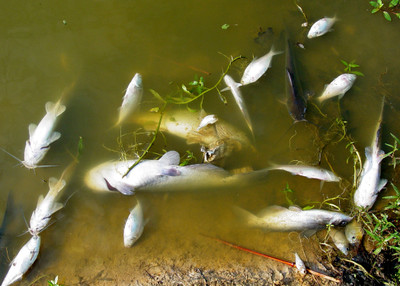Watch out for Fish Kills!
17th May 2018
Summer is upon us! Depending on what part of the country you are in you may be experiencing a gradual transition into summer, or if you are in the south it may feel as if that transition was overnight. The change of seasons can be marked by the heartbreak of fish kills due to pond turnover. However, your fish do not have to be a victim. Read on to learn how aeration can help the overall health of your pond and help keep your pond an asset.
We always recommend that pond owners consider installing an aeration system in their pond. An aeration system mechanically circulates the water providing numerous benefits to include increasing dissolved oxygen levels, eliminating pond turnover, increasing water quality, decreasing pond algae, and reducing the need for herbicide or chemical inputs.
First, aeration allows the pond to breathe thereby increasing oxygen levels. Increased dissolved oxygen levels mean that more fish can live and thrive in your pond. Water in the pond will separate into layers based on temperature and dissolved oxygen amounts in a process called stratification. Aeration helps in the destratification process by breaking up these layers so that the temperature, oxygen, nutrients and pH of the water are more evenly distributed throughout the entire water column. This means that fish can live in all areas of the pond and not just in the isolated layer with high dissolved oxygen.
When air temperatures increase or decrease with the change of seasons it can cause a natural mixing of the different layers called pond turnover. The turnover will force oxygen depleted water from the bottom to go to the top resulting in possible fish kills, foul smells, and cloudy water. Turnover can occur gradually over a few days or can be very sudden and occur in a few hours. Aeration prevents the turnover from occurring because it keeps the water circulating and stops the stratified layers from ever forming.
Aeration systems improve overall water quality by reducing harmful fertilizers, toxins and gases. Under oxygen deprived conditions lake-bottom sediments release various gases and metals that can cause water quality issues. Proper aeration allows for the release of these items at the air-water interface. In addition, aeration stabilizes the water’s pH, reduces alkalinity, and removes carbon dioxide.
The oxygen-rich water produced by the aeration system is circulated to the bottom of the pond where it can bind phosphorus and nitrogen to the sediments to control algae, duckweed and pond weeds. Beneficial bacteria that live in the pond sediment thrive in an oxygen rich environment (aerobic) which allows them to be much more effective at eating up or biodegrading the muck layer. In contrast, an oxygen-depleted environment allows for anaerobic bacteria to take over which produce foul-smelling gases and are very inefficient at reducing muck.
Aeration systems improve water quality thereby reducing the need for herbicides and chemicals. It evenly distributes the temperature, oxygen, nutrients, and pH of the water in the area affected by the system. These conditions allow fish to use more of the water body, grow larger, faster and healthier, and provides insurance against the heartbreak of a fish kill caused by low oxygen conditions. Overall, moving water is living water and aeration helps Mother Nature do her job resulting in a beautiful pond and a beautiful asset.
Stay tuned for our next article, types of aeration!

